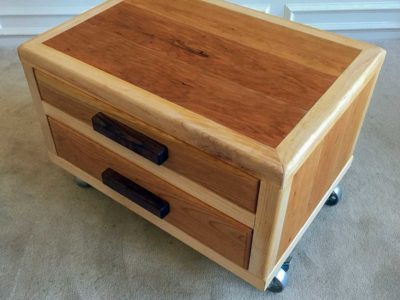I HAD AN ODD THOUGHT last week, while I was sanding on the hardwood table that my son and I were building out of cherry and maple.
It’s a small table, perfect for a small printer. We finished putting it together and we finally managed to coax the two drawers to cooperate with the slider hardware we bought.
But after we put it together, I noticed that we had a few spots where there was a bit of a lip sticking up, where two boards came together.
You couldn’t easily see the lip because we pieced the tabletop and the sides together with a tongue and groove technique— something we’ve never done before. But you could feel the lip when you rubbed your hands across the surface of the wood.
I knew I had to sand those lips and level them off. But I remember standing there sanding the table and thinking, “How much should I sand?”
The answer that came into my head right away was, “Everything that looks human.” Get the wood back to its natural grain.
When humans make something beautiful look ugly
That’s close to something my daughter once said when we were visiting an area in West Virginia. We were driving on dirt roads to see where my grandparents had lived. And my daughter said, “This would be such a beautiful place if it weren’t for people.”
The natural scenery was lovely. But alongside the dirt roads people had built rickety shacks surrounded by decades of junkyard trash: worn-out rubber wheels, rusted shells of cars, along with bumpers and buckets and barrels. Poverty does that to us.
Still sanding
Other sanding I needed to do on the table involved scratches, bumps, and sharp edges. There were also some wood waves. I don’t know what else to call them. When the lumber was run through a planar that produced the boards, it seemed to engrave into parts of the wood something that looks like rows of wooden waves. They’re tiny. But you can see them. You can feel them. And they’ve got to go.
Drifting thoughts, back to the Bible
Sanding hardwood is boring business. Maybe that’s why my mind took me back into the Bible, and to remembering the carpenter Jesus.
I’m pretty sure he did not sand wood with a Black & Decker sander loaded with 220-grit sandpaper. But he had to deal with imperfections in the wood.
I wonder if he made the connection between those man-made imperfections and the imperfections in our life— the sins we commit, the stupid decisions we make, and the selfishness we exhibit.
I don’t find it particularly comfortable to think of Jesus sanding spiritual imperfections out of me—splinters, sharp edges, and crooked lines.
But it did occur to me that the end result is what Christians want.
We want to be finished. We want the flaws gone. We want to feel good about ourselves.
So, here comes a Carpenter with sandpaper.
For some of us, he may need to start with the coarse sandpaper, 40-60-grit. Others will need only a finer grit, 220 or higher.
I’d like to say that the sanding feels like a back scratch. Comforting. Welcome. Enjoyable.
Sometimes it does.
But I’ve found that the carpentry work I need on my spirit too often involves Black & Decker, a wood chisel, and a router with a drill bit the size of a Cuban cigar.
I hope in the process that I’m shaping up. Getting smoother in spirit, softer around the edges, and more presentable to folks here and in the hereafter.
If not, at least my table looks nice.
Rx: Duct tape works
Some folks wanted a follow up to the article I wrote earlier: Doctor’s orders: wear duct tape.
I had a bump on my face and my daughter, a nurse practitioner, told me to go see my doctor. My doc told me to wear duct tape on it at night for two or three weeks. Then he charged me my $25 co-pay.
The bump is almost gone, shrinking away to nothing.
So I tried it on another bump, on one of my legs.
I showed it to my daughter and she told me to get that duct tape off of there. “It’ll only irritate it. Put on some antibiotic and a bandage.”
I had such high hopes for duct tape because I have such low regard for insurance companies.
Blog subscribers who win books this week
- Karen Hiner
- Erwin Vasquez
I give away free books every week to randomly selected Stateside subscribers to my free blog or my newsletter.
Winners get to choose from a stack of titles, including the Complete Guide to the Bible.
Note to the winner: send me an email and I’ll give you the full list of books from which you can choose.
The deal’s good for a month, or for as long as I have giveaway books available.


You did a great job on the table.
Thanks, George.
A friend of mine, Dave Rock, took my thoughts and developed them further. I thought you might enjoy reading what he had to say.
———–
To carry the analogy further.. if you put the stain and finish on over the top of the imperfections before the wood is ready, the imperfections show thru and are amplified. To fix them you start over by removing the finish and sanding down the rough spots. Then applying a new finish.
It’s a bit like the process of forgiveness in that we can’t cover up and hide what’s in our heart from God. Our hypocrisy is the shiny finish. Confession removes the coverup finish and begins the process of addressing the rough spots underneath.
Table looks great.
Dave
I took woodshop in high school and I am jealous of you and your son’s great work on the table on wheels. Using maple, cherry, and walnut looks great. I have a cousin whose father was a wood shop teacher and they both make and made beautiful items as you have done. Your work is quite professional looking.
Thanks Richard. It was wonderful to get to work with my son on this project.